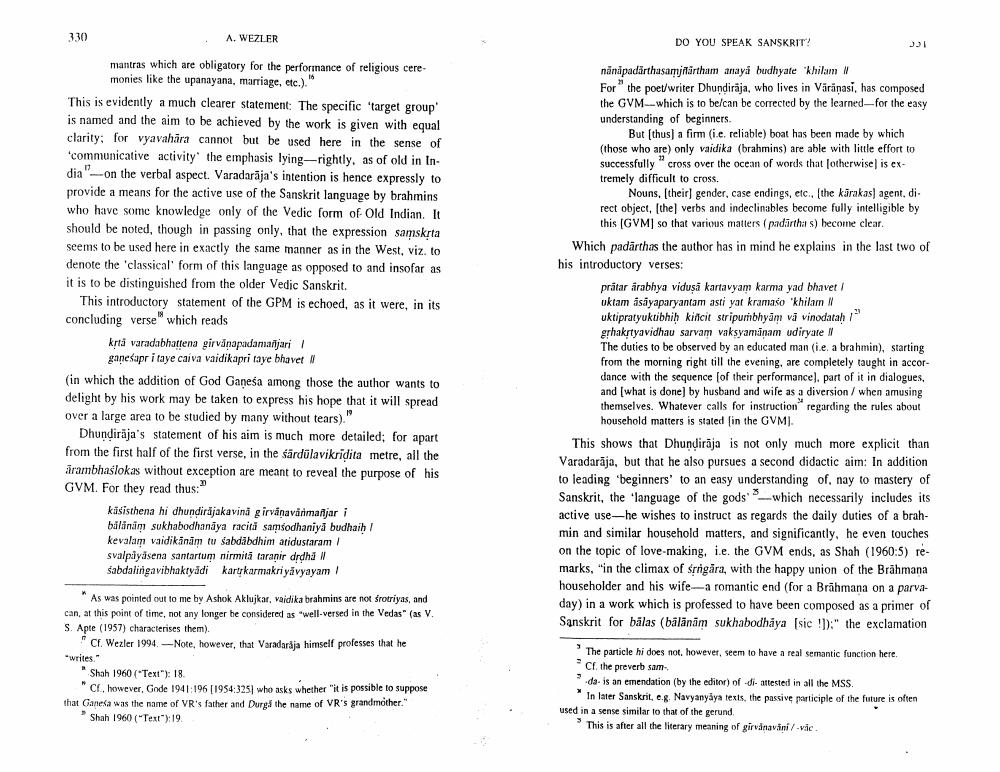________________
330
A. WEZLER
DO YOU SPEAK SANSKRIT?
mantras which are obligatory for the performance of religious cere
monies like the upanayana, marriage, etc.). This is evidently a much clearer statement: The specific 'target group is named and the aim to be achieved by the work is given with equal clarity; for vyavahāra cannot but be used here in the sense of 'communicative activity the emphasis lying-rightly, as of old in India" on the verbal aspect. Varadarāja's intention is hence expressly to provide a means for the active use of the Sanskrit language by brahmins who have some knowledge only of the Vedic form of Old Indian. It should be noted, though in passing only, that the expression samskrta seems to be used here in exactly the same manner as in the West, viz. to denote the 'classical form of this language as opposed to and insofar as it is to be distinguished from the older Vedic Sanskrit
This introductory statement of the GPM is echoed, as it were, in its concluding verse which reads
krå varadabhattena girvanapadamanījari /
ganesapr i taye caiva vaidikapri raye bhavet (in which the addition of God Ganesa among those the author wants to delight by his work may be taken to express his hope that it will spread over a large area to be studied by many without tears)."
Dhundiraja's statement of his aim is much more detailed; for apart from the first half of the first verse, in the särdülavikridita metre, all the ärambhaslokas without exception are meant to reveal the purpose of his GVM. For they read thus:
kasisthena hi dhundirajakavina girvanavärmafjari bilinim sukhabodhanaya racita samsodhaniya budhaih! kevalam vaidikanam tu sabdăbdhim atidustaram svalpyasena santartum nirmitā taranir drdha sabdalingavibhaktyádi kartkarmakriyavyayam
nanapadärthasamjitärtham anaya budhyate 'khitam For the poet writer Dhundiraja, who lives in Varanasi, has composed the GVM --which is to be can be corrected by the learned-for the easy understanding of beginners.
But (thus) a firm (i.e. reliable) boat has been made by which (those who are only vaidika (brahmins) are able with little effort to successfully cross over the ocean of words that otherwise is ex tremely difficult to cross.
Nouns, their gender, case endings, etc., the karakas) agent, direct object, (the verbs and indeclinables become fully intelligible by
this GVM) so that various matters (padithas) become clear Which padärthas the author has in mind he explains in the last two of his introductory verses:
pratar irabhya vidusä kartavyam karma yad bhavet / uktam asayaparyantam asti yar kramado 'khilam uktipratyuktibhih kiricit stripurbhyam và vinodatah 1 grhakrtyavidhau sarvam vaksyamanam udiryate The duties to be observed by an educated man (ie, a brahmin), starting from the morning right till the evening, are completely taught in accordance with the sequence of their performancel part of it in dialogues, and (what is done by husband and wife as a diversion / when amusing themselves. Whatever calls for instruction regarding the rules about
household matters is stated in the GVM). This shows that Dhundirāja is not only much more explicit than Varadarāja, but that he also pursues a second didactic aim: In addition to leading 'beginners' to an easy understanding of, nay to mastery of Sanskrit, the language of the gods which necessarily includes its active use--he wishes to instruct as regards the daily duties of a brahmin and similar household matters, and significantly, he even touches on the topic of love-making, i.e. the GVM ends, as Shah (1960:5) remarks, "in the climax of srngära, with the happy union of the Brāhmana householder and his wife-a romantic end (for a Brāhmana on a parva day) in a work which is professed to have been composed as a primer of Sanskrit for bālas (bälänām sukhabodhaya (sic!);" the exclamation
"As was pointed out to me by Ashok Aklujkar, vaidika brahmins are not srotriyas, and can, at this point of time, not any longer be considered as "well-versed in the Vedas" (as V. S. Apte (1957) characterises them).
Cr Wezler 1994-Note, however, that Varadaraja himself professes that he *writes
Shah 1960 ("Text"): 18.
CI, however, Gode 1941:196 [1954:325) who asks whether it is possible to suppose that Ganea was the name of VR's father and Durga the name of VR's grandmother."
Shah 1960 ("Text"):19.
The particle hi does not, however, seem to have a real semantic function here Cl, the preverb sam da is an emendation (by the editor) of di- attested in all the MSS.
In later Sanskrit, e.g. Navyanyāya texts, the passive participle of the future is often used in a sense similar to that of the gerund
This is after all the literary meaning of girvanavini/vic




